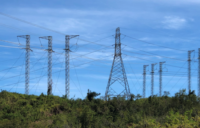While the federal government is helping to restore power to Puerto Rico as fast as it can, that work is being made more difficult due to the dilapidated, pre-Hurricane Maria state of the grid and because long-term, post-disaster power restoration is typically not the federal government's mission.
"We have been put in a terribly complex situation as a result of deferred maintenance and a system that was allowed to decay," Brock Long, the administrator of the Federal Emergency Management Agency, told a House committee on Nov. 2. "The thing is, a large portion of it never worked before Maria hit."
According to the Puerto Rico government, 42% of power has been restored to the island as of Nov. 6.
Gov. Ricardo Rossello has recently criticized the federal government for delays in restoring power to the island, complaining on news outlets about the small number of Corps personnel on the island. The Corps was tasked with restoring the grid on Sept. 30, 10 days after the storm made landfall. Because the Corps doesn't have standing contracts for long-term power restoration—local utilities usually handle that task themselves, with the help of mutual-aid agreements—it took almost three weeks to ink contracts with Fluor and other contractors from the time the Corps was given the its power-restoration mission.
As of Nov. 3, the Corps had four transmission crews, each with 10 linemen, and 16 distribution crews of about eight on the ground, a spokesman said. The Corps plans to have 181 crews working by the end of November, with the aid of contracts with Fluor and PowerSecure, Maj. Gen. Ed Jackson, deputy commanding general for civil and emergency operations for the Corps, told the committee.
Rep. Sean Maloney (D-N.Y.) said Rossello told him the island needs 2,000 crews to restore power—a number that Jackson couldn't comment on.
Jackson said, "I'd like to see what is driving the governor's assessment that we need 2,000."
Grid Decay
Other House Transportation and Infrastructure Committee members suggested the Puerto Rico Electric Power Authority (PREPA) and the island's government bore much of the blame for the slow pace of restoration, including failing to trigger mutual-aid agreements earlier, and for the overall condition of the grid.
Rep. Scott Perry, (R-Pa.) recited some of the details from a 2016 report on PREPA by energy consultants Synapse. Commissioned by the territory's utility commission, the scathing report said PREPA chronically underspent by deferring maintenance and extending outages, but it recorded $134 million in miscellaneous expenses in 2015—more than its entire budget for generation in 2017.
"PREPA's generating fleet has deteriorated rapidly over the last two fiscal years with a dramatically increased percentage of time in forced outages," according to the report. "While the underlying causes of these outages appear to be widespread, many of the outages can be linked to the deterioration of physical plants, including leaking pumps and valves, cracked ducts, [and] broken boilers, pipes, fans, and gates. The maintenance problems at PREPA's fleet have proceeded in lockstep with PREPA's declining generation and operational budgets."
Synapse said a team of engineers and auditors would be needed to fully evaluate PREPA's budget and spending.
Perry said PREPA's poor management was a "dereliction of duty." He asked Long whether it was the federal government's responsibility to be on the island "indefinitely," as some people have suggested. Long said no, adding, "I don't think we should be on the hook."
Contract Questions
The committee also asked Long about PREPA's $300-million contract with Whitefish Energy and a $200-million contract it signed with Cobra Acquisitions to help restore power.
While PREPA has canceled its contract with Whitefish, the contract with Cobra is still in place. Both contracts state that FEMA officials had reviewed the contracts and determined that they were in "an acceptable form to qualify for funding from FEMA or other U.S. Governmental agencies."
Rep. Peter DeFazio (D-Ore.) asked Long about the contracts. Long said they had not been reviewed by FEMA. "There's not a lawyer at FEMA that would have ever approved," he noted.
Sen. Claire McCaskill (D-Mo.) also is making inquiries into the contracts. On Nov. 2, she sent letters to FEMA, the Corps and Whitefish, asking a series of questions about the contracts. Other congressional committees are promising investigations, and the FBI is looking into the contracts, according to several published news reports.
Meanwhile, Whitefish remains on the island, with the expectation that, after the company leaves the island, its 350 subcontractors will continue to work under other contractors.
The company says it has restored 30 miles of transmission line, replaced six transmission towers, repaired 58 transmission towers and almost completed work on distribution lines in a portion of San Juan.
Mutual Aid
DeFazio said Rosello did not trigger mutual-aid agreements because FEMA had told him not to: The Corps was designated to restore power. Long said FEMA had not issued such an order.
"We have to get to the bottom of that," DeFazio said.
PREPA CEO Ricard Ramos formally requested mutual aid from New York and Florida on Oct. 31, asking for 600 linemen and associated equipment, as well as management, supervisory and administrative support to help coordinate restoration efforts. Under standard mutual-aid agreements, the requesting utility typically manages the logistics.
On Nov. 2, New York said it would send 350 personnel and 220 vehicles, the first 70 of which were loaded onto a cargo ship and sent the weekend of Nov. 3.
Separately, also on Nov. 3, a ship with 287 pieces of rolling stock, including bucket trucks, heavy equipment, cranes, mobile housing, office units and pole diggers, arrived on the island to help with power restoration.
The equipment was delivered as part of a $40-million contract the U.S. Army Corps of Engineers signed with Southern Co. subsidiary PowerSecure to provide 300 pieces of rolling stock and personnel to help restore the grid.
As part of another Corps contract, about 60,000 poles and 6,100 miles of transmission wire are scheduled to arrive within a week.
"We are getting this power grid up as fast as we can," Jackson told the committee. "We realize that what we are doing is nowhere going to be the ultimate in-state solution for where the grid needs to be."






Post a comment to this article
Report Abusive Comment